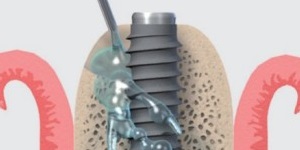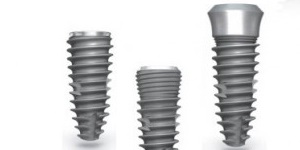
انتخاب وسایل برای برداشت پلاک و جرم از روی ایمپلنت
2015-11-10
روش های مراقبت و نگهداری از ایمپلنت
2015-11-11In a nutshell, cleaning around implants differs from maintenance of natural teeth for two reasons: The first is that each attaches to surrounding bone and gums in a very different way; secondly, the materials from which implants are made are very different from natural teeth
Dental implants replace the root parts of the teeth. Artificial crowns, bridgework or removable dentures — tooth replacements that make up the visible (crown) part/s of teeth — are attached to the implants. In between the implant and the crown of a tooth there is often a connector known as an abutment. The success of the whole system is based on the implant’s attachment to bone. Titanium, the metal of which implants are made, is uniquely osteophilic — literally “bone-loving.” It fuses to bone in a process called osseointegration “osseo” – bone; “integration” – fusion or joining)
Above the bone where the integration process ends, the abutment comes in contact with the gum tissue where it is supported by a connective i.e. “connecting”) tissue composed of fibers made of a tough material called collagen. The fibers run beneath the surface parallel to the implant ending at the top of the bone. They hold the gum tissues against the implant surface
At the very top of the implant assembly, the abutment and lower part of the crown attach to the gum (the surface “skin” layer) via a specialized structure known as an epithelial attachment (“epi” – on top; “thele” – nipple). The cells actually attach to the highly polished metal or ceramic, of which the implants are made, by means of microscopic suction pads
By contrast, a tooth root is attached to the bony socket that surrounds it — by a periodontal ligament (“peri” – around; “odont” – tooth). The ligament is composed of tiny fibers that insert into the bone on one side and into the tooth root on the other. Above the bone, the fibers attach from the tooth into the gum tissue. An implant has no such attachment. Since the whole periodontal ligament has a greater blood vessel supply through which it can bring cells and nutrients, it is more readily able to resist and fight against infection
Infection Is The Enemy
Cleaning implant-supported tooth replacements is just as important as cleaning natural teeth, as both depend on healthy surrounding tissues for support. Bacterial biofilm (plaque) collects on implant crowns just as it does on natural teeth, and must be removed on a daily basis at home. Without daily biofilm removal, infection can develop known as peri-implantitis (“peri” – around; implant “itis” – inflammation), which can result in loss of the attachment described above. Unlike inflammation around teeth, this reaction can be quite catastrophic both in rate and amount, quickly leading to a well- or dish-shaped loss of bone around an affected implant. Bone loss can rapidly progress to loss of the implant
The dental hygienist has an important role to play in keeping dental implants infection-free, and there are many factors to be considered in selecting the right instruments for a professional cleaning. They include: the nature of the debris, meaning whether soft (biofilm, foods) or hard (calculus or tartar, calcified material); the location of the deposits; the type of surface on which they accumulate; and the stubbornness with which they adhere
related content
reference






